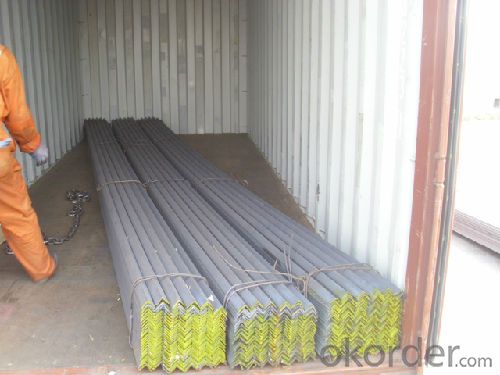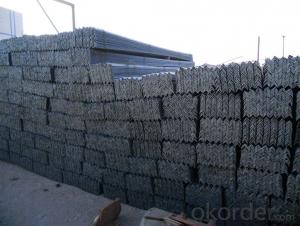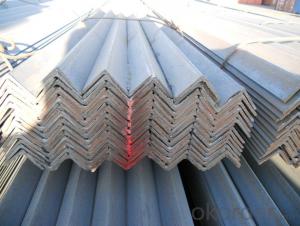Hot Rolled Steel Bar Equal Bar Unequal Bar Q235
- Loading Port:
- Tianjin
- Payment Terms:
- TT or LC
- Min Order Qty:
- 25 m.t.
- Supply Capability:
- 30000 m.t./month
OKorder Service Pledge
OKorder Financial Service
You Might Also Like
Product Description:
OKorder is offering Hot Rolled Steel Bar Equal Bar Unequal Bar Q235 at great prices with worldwide shipping. Our supplier is a world-class manufacturer of steel, with our products utilized the world over. OKorder annually supplies products to European, North American and Asian markets. We provide quotations within 24 hours of receiving an inquiry and guarantee competitive prices.
Product Applications:
Hot Rolled Steel Bar Equal Bar Unequal Bar Q235 are ideal for structural applications and are widely used in the construction of buildings and bridges, and the manufacturing, petrochemical, and transportation industries.
Product Advantages:
OKorder's Hot Rolled Steel Bar Equal Bar Unequal Bar Q235 are durable, strong, and resist corrosion.
Main Product Features:
· Premium quality
· Prompt delivery & seaworthy packing (30 days after receiving deposit)
· Corrosion resistance
· Can be recycled and reused
· Mill test certification
· Professional Service
· Competitive pricing
Product Specifications:
Specifications of Angle Steel
1. Invoicing on theoretical weight or actual weight as customer request
2. Length: 6m, 9m, 12m as following table
3. Sizes

Sizes: 25mm-250mm | ||
a*t | ||
25*2.5-4.0 | 70*6.0-9.0 | 130*9.0-15 |
30*2.5-6.6 | 75*6.0-9.0 | 140*10-14 |
36*3.0-5.0 | 80*5.0-10 | 150*10-20 |
38*2.3-6.0 | 90*7.0-10 | 160*10-16 |
40*3.0-5.0 | 100*6.0-12 | 175*12-15 |
45*4.0-6.0 | 110*8.0-10 | 180*12-18 |
50*4.0-6.0 | 120*6.0-15 | 200*14-25 |
60*4.0-8.0 | 125*8.0-14 | 250*25 |
5. Payment terms:
1).100% irrevocable L/C at sight.
2).30% T/T prepaid and the balance against the copy of B/L.
3).30% T/T prepaid and the balance against L/C
6.Material details:
Alloy No | Grade | Element (%) | |||||
C | Mn | S | P | Si | |||
|
|
|
|
|
|
| |
Q235 | B | 0.12—0.20 | 0.3—0.7 | ≤0.045 | ≤0.045 | ≤0.3 | |
|
|
|
|
|
|
| |
Alloy No | Grade | Yielding strength point( Mpa) | |||||
Thickness (mm) | |||||||
≤16 | >16--40 | >40--60 | >60--100 | ||||
≥ | |||||||
|
|
|
|
|
| ||
Q235 | B | 235 | 225 | 215 | 205 | ||
Alloy No | Grade | Tensile strength (Mpa) | Elongation after fracture (%) | ||||
Thickness (mm) | |||||||
| ≤16 | >16--40 | >40--60 | >60--100 | |||
≥ | |||||||
|
|
|
|
|
|
| |
Q235 | B | 375--500 | 26 | 25 | 24 | 23 | |
Usage & Applications of Angle Steel
According to the needs of different structures, Angle can compose to different force support component, and also can be the connections between components. It is widely used in various building structures and engineering structures such as roof beams, bridges, transmission towers, hoisting machinery and transport machinery, ships, industrial furnaces, reaction tower, container frame and warehouse etc.
Packaging & Delivery of Angle Steel
1. Packing: it is nude packed in bundles by steel wire rod
2. Bundle weight: not more than 3.5MT for bulk vessel; less than 3 MT for container load
3. Marks:
Color marking: There will be color marking on both end of the bundle for the cargo delivered by bulk vessel. That makes it easily to distinguish at the destination port.
Tag mark: there will be tag mark tied up on the bundles. The information usually including supplier logo and name, product name, made in China, shipping marks and other information request by the customer.
If loading by container the marking is not needed, but we will prepare it as customer request.
Production flow of Angle Steel
Material prepare (billet) —heat up—rough rolling—precision rolling—cooling—packing—storage and transportation
FAQ:
Q1: Why buy Materials & Equipment from OKorder.com?
A1: All products offered byOKorder.com are carefully selected from China's most reliable manufacturing enterprises. Through its ISO certifications, OKorder.com adheres to the highest standards and a commitment to supply chain safety and customer satisfaction.
Q2: How do we guarantee the quality of our products?
A2: We have established an advanced quality management system which conducts strict quality tests at every step, from raw materials to the final product. At the same time, we provide extensive follow-up service assurances as required.
Q3: How soon can we receive the product after purchase?
A3: Within three days of placing an order, we will begin production. The specific shipping date is dependent upon international and government factors, but is typically 7 to 10 workdays.
Q4: What makes stainless steel stainless?
A4: Stainless steel must contain at least 10.5 % chromium. It is this element that reacts with the oxygen in the air to form a complex chrome-oxide surface layer that is invisible but strong enough to prevent further oxygen from "staining" (rusting) the surface. Higher levels of chromium and the addition of other alloying elements such as nickel and molybdenum enhance this surface layer and improve the corrosion resistance of the stainless material.
Q5: Can stainless steel rust?
A5: Stainless does not "rust" as you think of regular steel rusting with a red oxide on the surface that flakes off. If you see red rust it is probably due to some iron particles that have contaminated the surface of the stainless steel and it is these iron particles that are rusting. Look at the source of the rusting and see if you can remove it from the surface.
Images:



- Q:What are the different types of steel angles used in manufacturing?
- In manufacturing, a variety of steel angles are utilized, each possessing unique characteristics and applications. Some commonly encountered types include: 1. Equal Angle: This steel angle features equal sides and angles, forming a 90-degree angle. It finds frequent use in structural applications where strength and stability are paramount, such as framing and supports. 2. Unequal Angle: As its name implies, this steel angle possesses unequal sides and angles. It is often employed in applications necessitating varying load-bearing capacities or the creation of different shapes during manufacturing processes. 3. L-Angle: This steel angle, also referred to as L-shaped angles, exhibits a 90-degree bend with unequal sides. It sees common use in reinforcing corners, as well as in construction and fabrication projects. 4. T-Angle: T-angles possess a T-shaped cross-section, with one side extending vertically and the other horizontally. They are frequently utilized as structural supports or in applications requiring additional strength and rigidity. 5. Flat Bar Angle: This steel angle possesses a flat surface on one side and a right-angle bend on the other. It is commonly employed for bracing, supports, and framing in manufacturing and construction projects. 6. Slotted Angle: Slotted angles are characterized by having holes or slots running along their length, allowing for convenient adjustment and customization. They find regular use in shelving, racks, and storage systems within manufacturing and warehouse environments. These examples merely scratch the surface of the diverse range of steel angles employed in manufacturing. The specific type chosen depends on project requirements such as load-bearing capacity, structural integrity, and desired shape or configuration.
- Q:What are the different methods of connecting steel angles?
- There are several methods of connecting steel angles, depending on the specific application and desired level of strength and durability. Some common methods include welding, bolting, and using mechanical connectors. 1. Welding: Welding is a widely used method of connecting steel angles. It involves melting the metals at the joint and allowing them to cool and solidify, creating a strong and permanent bond. Welding can be done using various techniques such as arc welding, MIG welding, or TIG welding. It provides a high level of strength and rigidity to the connection. 2. Bolting: Bolting is another common method of connecting steel angles. It involves using bolts, nuts, and washers to secure the angles together. This method allows for easy disassembly and reassembly if needed. Bolts can be tightened to achieve the desired level of tightness and strength in the connection. However, bolting may not offer the same level of strength as welding in certain applications. 3. Mechanical connectors: Mechanical connectors provide an alternative to welding and bolting for connecting steel angles. They are pre-engineered devices specifically designed for connecting steel members. These connectors typically consist of plates, brackets, or clips that are fastened to the angles using bolts or screws. Mechanical connectors offer ease of installation, flexibility, and the ability to accommodate movement and adjustments. 4. Adhesive bonding: Adhesive bonding involves using industrial-grade adhesives to join steel angles together. This method can provide a strong and durable connection, particularly when used in conjunction with mechanical fasteners. Adhesive bonding is often used in applications where welding or bolting may not be suitable or practical. It is important to consider factors such as load-bearing capacity, environmental conditions, and aesthetic requirements when selecting the appropriate method of connecting steel angles. Consulting with a structural engineer or a professional experienced in steel fabrication can help determine the most suitable connection method for a specific project.
- Q:What is the standard tolerance for steel angles?
- Depending on the specific requirements and industry standards, the standard tolerance for steel angles can vary. Typically, the permissible variation in dimensions such as length, width, and thickness is used to specify the standard tolerance for steel angles. These tolerances guarantee that the angles meet the necessary specifications and are suitable for different applications. To determine the specific tolerance requirements for steel angles in a particular context, it is important to refer to relevant industry standards or specifications provided by organizations like ASTM or AISC.
- Q:What are the different grades of steel used for manufacturing steel angles?
- The different grades of steel used for manufacturing steel angles include A36, A572, A588, and A992.
- Q:Can steel angles be used for equipment racks?
- Yes, steel angles can be used for equipment racks. Steel angles are versatile and strong, making them suitable for various applications including equipment racks. They provide structural support and can be easily fabricated to meet specific requirements. Additionally, steel angles are resistant to corrosion and can bear heavy loads, making them an ideal choice for equipment racks that need to support heavy equipment.
- Q:Can steel angles be used as reinforcement in concrete structures?
- Yes, steel angles can be used as reinforcement in concrete structures. Steel angles are often used as L-shaped or angle-shaped bars that are embedded within the concrete to provide additional strength and support to the structure. These angles help to resist tensile forces and prevent cracking or failure of the concrete. They are commonly used in applications such as beams, columns, and walls to enhance the structural integrity and load-bearing capacity of the concrete elements. Additionally, steel angles can be easily welded or bolted together, making them a versatile and cost-effective choice for reinforcement in concrete structures.
- Q:Can steel angles be used for electrical conduits or cable trays?
- Depending on project requirements and regulations, steel angles can serve as support structures for electrical conduits or cable trays. These angles are well-known for their strength and durability, making them commonly used as structural supports. However, when considering their use for electrical conduits or cable trays, it is imperative to ensure that they meet the necessary electrical and safety codes. Electrical conduits and cable trays are specifically designed to house and protect electrical wires or cables in a safe manner. These systems must be capable of withstanding the weight of the cables, providing proper grounding, and offering sufficient protection against physical damage, moisture, and other potential hazards. Steel angles can be employed as support structures for electrical conduits or cable trays, providing a robust framework for the installation and securement of the system. However, it is crucial to ensure that the steel angles are effectively grounded, insulated, and guarded against corrosion to meet all electrical safety standards. Furthermore, the selection of the appropriate size and dimensions for the steel angles should be based on the weight and size of the cables or wires being installed. To guarantee compliance with all necessary requirements, it is important to consult with electrical engineers or professionals who are familiar with local electrical codes and standards. In conclusion, while steel angles can be utilized for electrical conduits or cable trays, it is essential to carefully consider the specific requirements and regulations of the project to ensure electrical safety and compliance.
- Q:What are the standard sizes for steel angles?
- Steel angles come in different sizes depending on the country and industry standards. They have a wide range of sizes to suit various applications and structural needs. Equal angles, with sides of equal length, and unequal angles, with different side lengths, are commonly available. Standard sizes for steel angles include 25x25mm, 30x30mm, 40x40mm, 50x50mm, 65x65mm, 75x75mm, 100x100mm, 150x150mm, and 200x200mm. However, it's important to keep in mind that these sizes can vary and can be customized to meet specific project requirements and regional standards.
- Q:How do you maintain and clean steel angles?
- To maintain and clean steel angles, you can start by removing any dirt or debris using a mild soap and water solution. Avoid using abrasive cleaners or tools that can scratch the surface of the steel. After cleaning, it is important to thoroughly dry the angles to prevent any water spots or rust formation. Applying a protective coating or wax can also help maintain their appearance and prevent corrosion. Regular inspections and prompt removal of any rust spots or stains will ensure the longevity of the steel angles.
- Q:Can steel angles be used in modular or prefabricated construction?
- Indeed, modular or prefabricated construction can make use of steel angles. The strength and versatility of steel angles make them popular as structural elements in construction. They can be conveniently fabricated and incorporated into modular or prefabricated building systems, resulting in efficient and economical construction procedures. Steel angles can fulfill multiple purposes such as providing structural support, reinforcing connections, and forming framing systems in modular or prefabricated buildings. Moreover, their capability to be tailored and adjusted to meet different design specifications renders them suitable for a diverse array of building applications within the modular or prefabricated construction sector.
1. Manufacturer Overview |
|
|---|---|
| Location | |
| Year Established | |
| Annual Output Value | |
| Main Markets | |
| Company Certifications | |
2. Manufacturer Certificates |
|
|---|---|
| a) Certification Name | |
| Range | |
| Reference | |
| Validity Period | |
3. Manufacturer Capability |
|
|---|---|
| a)Trade Capacity | |
| Nearest Port | |
| Export Percentage | |
| No.of Employees in Trade Department | |
| Language Spoken: | |
| b)Factory Information | |
| Factory Size: | |
| No. of Production Lines | |
| Contract Manufacturing | |
| Product Price Range | |
Send your message to us
Hot Rolled Steel Bar Equal Bar Unequal Bar Q235
- Loading Port:
- Tianjin
- Payment Terms:
- TT or LC
- Min Order Qty:
- 25 m.t.
- Supply Capability:
- 30000 m.t./month
OKorder Service Pledge
OKorder Financial Service
Similar products
New products
Hot products
Hot Searches
Related keywords



























